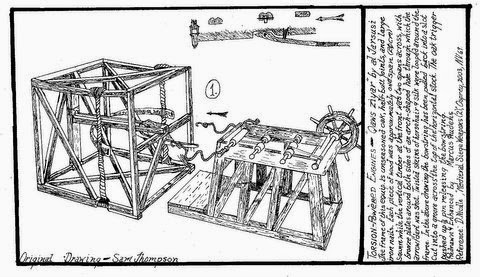The frame of this equipment is unseasoned oak, put together with
half-butt joints, and large iron nails. Each piece of wood used in
the construction of this weapon was approximately one span (20 cm)
square while the vertical timber at the front of the weapon
was two spans across with bronze plates around both sides
of an arch shaped hole through which the arrow / dart was shot.
Twisted skiens of horsehair and silk were looped around the frame.
In the above drawing the bowstring has been pulled back into a slot
cut into a groove across the top of the horizontal stock. The oak
trigger pushed up a pin releasing the bowstring.
Redrawn and Enhanced by Marcus Audens.
Reference; D. Nicolle, "Medieval Siege Weapons (2)." Osprey, 2003, N.V. 69 |



